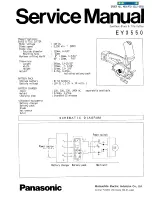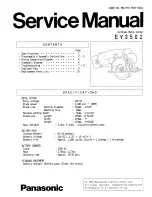
5. Technical data
AC motor
230 V ~ 50 Hz
Power P
2000 watts
Idle speed n
0
3900 min
-1
Cutting-off wheel
Ø 355 x Ø 25.4 x 3.2 mm
Footprint
445 x 245 mm
Swiveling range
0 - 45° mm
Vise clamping range max.
0 - 240 mm
Saw width at 90°
Ø 100 / 70 x 170 mm
Saw width at 45°
100 x 70 mm
Weight 19.6
kg
6. Before putting the machine into
operation
Unpack the metal cutting-off machine and check
it for damage which may have occurred in
transit.
The machine has to be set up where it can stand
firmly, e.g. on a work bench, or it must be bolted
to a strong base.
All covers and safety devices have to be pro-
perly fitted before the machine is switched on.
It must be possible for the cutting-off wheel to
run freely.
Before you actuate the ON/OFF switch, make
sure that the cutting-off wheel is correctly fitted
and that the machine’s moving parts run
smoothly.
Before you connect the machine to the power
supply, make sure the data on the rating plate is
the same as that for your mains.
7. Assembly
Caution! Pull out the power plug before carrying
out any maintenance, resetting or assembly work
on the cutting-off machine!
7.1 Transport brace / carry-handle (Fig. 1 / 2)
The saw head (1) is anchored in its lower
position with a chain (13). (Fig. 2)
Push down the saw head (1) by the handle (2)
and unhook the chain (13).
Slowly raise the saw head (1).
Caution! The resetting spring lifts the saw head
(1) automatically. Therefore, do not simply let go
of the handle (2) after cutting, but allow the saw
head (1) to rise slowly by applying slight
counterpressure.
Fig.1 shows the saw head (1) in its upper
position.
Whenever you want to transport the machine
you should use the chain (13) to anchor the saw
head (1) again in its lower position.
The saw is equipped with a carry-handle (8) to
make it easier to transport.
7.2. Vise (Fig. 3 / 4)
Every workpiece has to be fastened in the vise (15)
before it is cut.
Flip up the top half of the nut (14).
Pull out the spindle (5) far enough for the work-
piece to be clamped between the clamping faces
(4/7) of the vise (15).
Note:
You do not have to turn the spindle (5)
when the top half of the nut (14) has been
flipped up. The spindle (5) can be pulled out or
pushed in to the exact amount required.
Push forward the spindle (5) to the point where
the clamping face (4) touches the workpiece.
Flip down the top half of the nut (14) again so
that the spindle (5) and both halves of the nut
engage with each other.
Turn the hand crank (6) to safely secure the
workpiece in the vise (15).
7.3. Miter cuts (Fig. 5)
The vise can be swiveled from 0° to 45° in order to
make miter cuts.
Slacken the two screws (16/17).
Turn the clamping face (7) of the vise (15) to the
required angle.
Retighten the screws (16/17).
When you clamp the workpiece, the front
clamping face (4) will automatically swing into
the correct position and align itself with the
workpiece in order to ensure that the workpiece
is safely fastened.
7.4. Adjusting the stop screw (Fig. 6)
The downward movement of the cutting-off wheel
can be adjusted with the stop screw (18).
This is necessary to compensate wheel wear – as
the cutting-off wheel becomes smaller in diameter it
would no longer be able to cut right through the
workpiece.
Undo the lock nut (19).
Turn the stop screw (18) in or out as required.
Lower the saw head (1) to check whether the
cutting off wheel (11) reaches the clamping face
(7) of the vise (15 ).
Retighten the lock nut (19).
GB
14
Anleitung MS 355-1 Herkules SPK7 17.03.2006 11:18 Uhr Seite 14















































